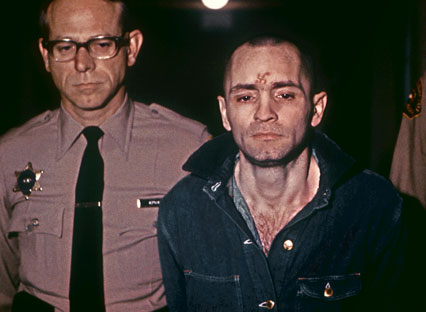Who were the Manson Family - and where are they now?
New Quentin Tarantino movie takes inspiration from gruesome murder of Sharon Tate

Quentin Tarantino’s ninth film, Once Upon a Time In Hollywood, puts the director's familiar idiosyncratic spin on the real-life Manson Family murders of 1969.
Described as a “hymn to old Hollywood” by The Guardian, the film departs from reality in its handling of the gruesome crime, in which pregnant film star Sharon Tate and four others were murdered by members of the cult.
The movie stars Brad Pitt as Hollywood stuntman Cliff Booth and Leonardo DiCaprio as washed-up western star Rick Dalton, who rails against the cult members as “hippies”.
The Week
Escape your echo chamber. Get the facts behind the news, plus analysis from multiple perspectives.

Sign up for The Week's Free Newsletters
From our morning news briefing to a weekly Good News Newsletter, get the best of The Week delivered directly to your inbox.
From our morning news briefing to a weekly Good News Newsletter, get the best of The Week delivered directly to your inbox.
“Charles Manson and the brainwashed members of the Manson family technically were not hippies. They were killer sheep in hippie clothing,” says Vulture.
So what was the Manson Family cult - and why does it continue to haunt us to this day?
Who was Charles Manson?
The so-called Manson Family started life as one of the many “alternative” communes which arose from the hippie movement of the late 1960s.
A free daily email with the biggest news stories of the day – and the best features from TheWeek.com
Charles Manson, a charismatic aspiring musician with a long criminal history, attracted a devoted coterie of mostly young and female followers in the San Francisco area in the mid-1960s.
In the summer of 1968, he moved the group to Spahn Ranch, a Western-style compound near Los Angeles. There, Manson’s worldview grew increasingly radical and violent.
Based on his interpretation of the biblical Book of Revelations and lyrics from The Beatles’ White Album, Manson described an imminent race war between black and white Americans, which the cult would escape by taking refuge in an underground hideout.
In an attempt to spark this war, Manson orchestrated two gruesome home invasions which left six people dead. He had hoped to frame the Black Panthers for the killings.
What were the Manson Family murders?
On the night of 9 August 1969, Manson’s right-hand man Tex Watson and three female followers - Susan Atkins, Linda Kasabian, and Patricia Krenwinkel - entered a house occupied by actress Sharon Tate and director Roman Polanski, who was not at home.
Tate, who was eight months pregnant, was stabbed to death in a frenzied attack, alongside three friends who were visiting and a teenage guest of the property’s groundskeeper.
The next night, the gang of four, joined by fellow members Leslie Van Houten and Steve "Clem" Grogan, stabbed Leo LaBianca and his wife Rosemary to death in their home in the Los Feliz area of Los Angeles.
The Tate-LaBianca murders were the most high-profile of a string of crimes committed by the Manson Family, including at least two other murders and the attempted assassination of President Gerald Ford in 1975.
What happened to Manson and his followers?
Although Manson was never convicted of personal involvement in any of the killings he masterminded, in 1971 a jury found him guilty of first-degree murder for his part in orchestrating the murders.
At their trial, Manson Family members “shamelessly admitted their crimes and flaunted their allegiance to a leader whom they said they loved and who was portrayed as controlling their minds”, The New York Times reports.
All the cult members who had participated in the Tate-LaBianca murders were handed lengthy prison sentences.
Charles “Tex” Watson, who led the gruesome double-murder spree, was initially sentenced to death, but a reform of California’s penal system resulted in it being downgraded to life imprisonment. Still incarcerated at the age 72, he is now an ordained Christian minister - although that has not prevented him fathering a rumoured four children through conjugal visits, according to The New York Times.
Former high school homecoming queen Leslie Van Houten admitted to stabbing Rosemary LaBianca between 14 and 16 times. Van Houten “lost any real chance at public support when she giggled during her trial testimony in 1970”, says Rolling Stone, although she has long been considered a model prisoner.
Like all her co-defendants, Patricia Krenwinkel, who was 19 at the time of the murders, ultimately renounced Manson. Now aged 71, she will become California’s longest-serving female prisoner if Van Houten is released, having been denied parole over a dozen times.
Susan Atkins, who reportedly told her cellmates that she had been the one to stab Tate to death, became a born-again Christian in the 1970s. She died of brain cancer in prison in 2009 aged 61.
Steve “Clem” Grogan, who drove the killers to the LaBianca house but left before the murders, was convicted of helping Manson and Watson murder Spahn ranch worker Donald Shea in a separate incident. He was paroled in 1985 and now lives in California.
Linda Kasabian, who witnessed the Tate-LaBianca murders but was the only member not to participate, became the key witness for the prosecution in exchange for her own immunity. After the trial, she returned to her family’s home in New Hampshire and has shunned the spotlight in favour of a quiet life.
Manson died in prison in 2017 at the age of 83, but the memory of the cult’s gruesome murder spree, which terrified Los Angeles area in the summer of 1969, will loom large for decades to come.



